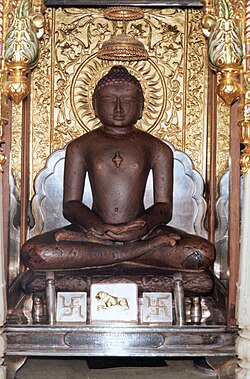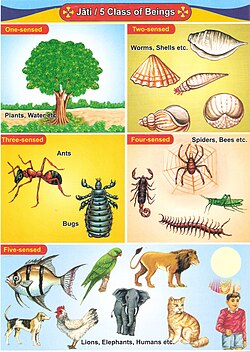Jainism and environmental conservation
Read community contributed articles on biodiversity & environment || Cultural practices & mythological stories related to Indian biodiversity || Checklists of Indian species || Conservation issues library || Official documents related to environment || NGOs, Blogs and Websites || Environment-related video collection || Plants of India || Mammals of India || Facebook || Twitter
Contents
Jainism and environmental conservation
Author: Devanshi Khokhani
Jainism ( जैनधर्म - Jainadharma) is one of the most environmentally conscious religions in the world. The religion is based on the principal of non-violence towards all living beings. The religion is thought to have its roots in the Indus Valley Civilization and the later Vedic Civilization, a period of intense philosophical deliberations on the Indian subcontinent. Jainism was firmly established in India between 9th and 6th century BC. Today, there are over 4 million followers of Jainism in India and around the world[1].
Vardhaman Mahavir
The most important religious holiday for Jains worldwide is Mahavir Jayanti, the birthday of Lord Mahavir. Lord Mahavir was the 24th and the last Tirthankar in Jainism who played an important role in defining the Jain religion as it exists today.
Bhagwaan Mahavir, who is also known as Vardhaman Mahavir, was born in 599 BC in Kundgram near Vaishali of Bihar in India in the royal family of King Siddartha and Queen Trishala . After 30 years as a householder, he abandoned his family and went to the forests to perform a penance. After about 12 and half years of severe penance he attained “Keval Gyan” (Omniscience). Since then he preached non violence to people and insisted to inculcate the feeling of compassion towards all forms of living beings. He, himself set as an excellent example by remaining calm and forgiving all the creatures who imposed severe austerities on him. He is the last tirthankar of the 24 tirthankaras , who attained salvation on New Moon Day of Kartik, 527 B.C.E at Pavapuri in state of Bihar in India.
Non violence – the basis of Jainism
Ahimsa-paramo-dharmah (non-injury to living beings) is one of the basic virtues of Jainism. To kill a living being is considered to be the greatest of sins. Practice of non violence is not just limited to humans or animals but is extended to all forms of life. All living beings are regarded as equal[2]. Jainism also stresses on the moral responsibility of the humans in their mutual dealings and relationships with the rest of the universe and hence it is a religion of compassion – it aims at the welfare of all living beings. An important principle of Jainism is expressed in Sutrakrta-anga (1.11.33) as follows:
A man should wander about treating all creatures as he himself would be treated.[3]Apart from preventing oneself from act of injury or killing, Jainism also considers controlling emotions like aggression, possession, and consumption that are usually the root causes of violence in today’s world.
The core beliefs of Jainism, listed on this Wikipedia page, demonstrate how close the beliefs are to the ethos of environmental sustainability.
Nature and Jainism
Jain Agams depict nature in a very unique way as it says that five main elements of nature; Prithvi (land, soil, stones, etc), Jal (Water resources including cloud), Agni (Fire), Vayu (Air) and Aakash (Sky) are living creatures and must be treated as living beings. These five types of elements go on to form five classes of beings (as shown alongside) such as vegetation, trees and plants, fungi and animals. This unique concept of Jainism restricts its followers to harm any creature and eventually leads to limited consumption as well as help in protecting environment[4].
Lord Mahavira, who lived in forests and jungles most of the times during his asceticism, attained Keval gyan (omniscience) on the bank of river Rijuvalika below a shal tree. It is noteworthy that Mahavira is the 24th and last Tirthankar of Jain and all others also lived their ascetic life in similar manner. They preached sitting in Samavasharana after enlightenment. The Samavasharana itself is a complete ecosystem. Lord Mahavira has clearly warned in Acharanga Sutra, first Jain Anga Sutra, that contamination of any natural resources is not desirable in any case. He has gone in to details of contamination. Jainism considers these as weapons to creatures (natural resources)[4].
One of the ways Jain monks or the followers of Jainism, observe non violence is by restraining themselves from eating the roots like potato, radish, carrots, ginger etc, especially during the 4 months of rainy season. The reason behind this is they think that during harvest of these vegetables, earth is dug out and the soil organisms are killed more during rainy season. Jains called this period as “Chaumasu” or “Chaturmas”. In this period, even the monks do not wander from one place to another in order to avoid any unintentional killing of any form of life. For example, on a rainy day, they would observe fasts as they cannot walk on the wet streets to get “Gochari” (get food for themselves).
Jain scriptures motivate people for minimal consumption. They emphasize on Tyaga (Sacrifice). Jain Sharavaka / Shravikas (Laymen and women) are preached to minimize their Bhoga (Consumables). The seventh vow for Jain households is Bhogopbhog Pariman Vrata (Vow). This vow restricts them from unlimited consuming of natural resources. Moreover, this vow is a Shiksha Vrata (Educational vow). It preaches its observers to learn and educate themselves towards limiting their consumables.
Other media
| The story of Jainism | Jainism and nonviolence |
|---|---|
References
- ^ "Indian Census". Censusindia.gov.in. Retrieved 2010-09-01
- ^ Jainism - Religioustolerance.org Accessed: April 2, 2012
- ^ http://blog.jainee.com/2009/08/jainism-and-environment-part-1.html Jainism and environment] Accessed: April 2, 2012
- ^ a b Jyoti Kothari at Hubpages.com Accessed: April 2, 2012
Comments
blog comments powered by DisqusMore notes like this
| |||||||||||||||||||||||||||||||||||||||||||||||||||||||||||||||||||||||||||||||||||||
Only 15 articles are shown in this list. A total of 65 articles in the database as of this moment. For the complete list, click on further results on the bottom right corner of the above table.
Semantic tags
- Browse all Semantic Tags associated with this page
- Find more pages and articles created by the community by clicking this link.
| Title | Jainism and environmental conservation | Article is on this general topic | Mythology and religion | Author | Devanshi Khokhani |
|---|---|---|---|---|---|
| Specific location(s) where study was conducted | Not noted | General region where study was conducted | Not noted | State where study was conducted | Pan-India |
| Institutional affiliation | Not noted | Institution located at | Not noted | Institution based around | Not noted |
| Species Group | Not noted | User ID | User:Not noted | Page creation date | 2012/04/02 |
Share this page:

